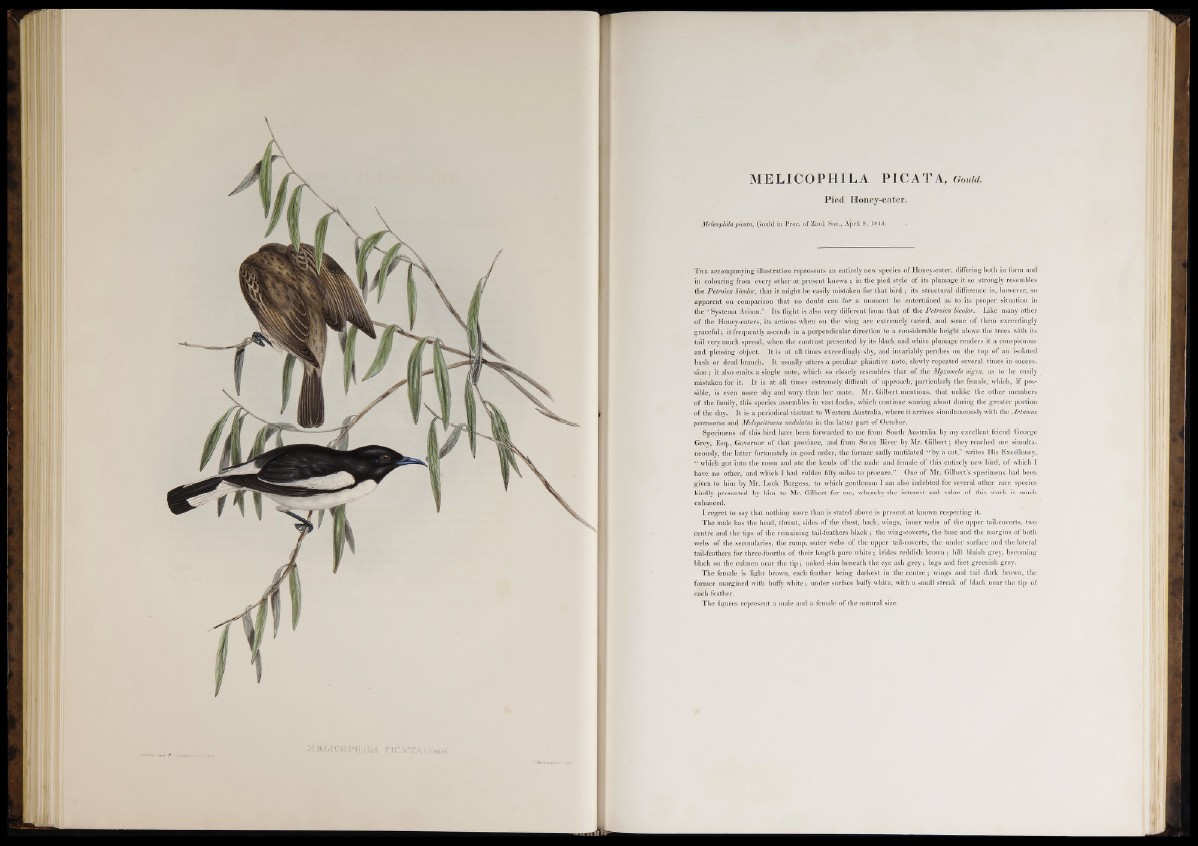
MELICO PHI LA PICATA, Gouid.
Pied Honey-eater.
Melicophila picata, Could in Proc. of Zool. Soc., April 9, 1844.
T h e accompanying illustration represents an entirely new species of Honey-eater, differing both in form and
in colouring from every other at present known ; in the pied style of its plumage it so strongly resembles
the Petroica bicolor, that it might be easily mistaken for that bird ; its structural difference is, however, so
apparent on comparison that no doubt can for a moment be entertained as to its proper situation in
the ‘ Systema Avium.’ Its flight is also very different from that of the Petroica bicolor. Like many other
o f the Honey-eaters, its actions when on the wing are extremely varied, and some of them exceedingly
graceful; it frequently ascends in a perpendicular direction to a considerable height above the trees with its
tail very much spread, when the contrast presented by its black and white plumage renders it a conspicuous
and pleasing object. It is at all times exceedingly shy, and invariably perches on the top of an isolated
bush or dead branch. It usually utters a peculiar plaintive note, slowly repeated several times in succession
; it also emits a single note, which so closely resembles that o f the Myzomela nigra, as to be easily
mistaken for it. It is at all times extremely difficult of approach, particularly the female, which, if possible,
is even more shy and wary than her mate. Mr. Gilbert mentions, that unlike the other members
o f the family, this species assembles in vast flocks, which continue soaring about during the greater portion
of the day. It is a periodical visitant to Western Australia, where it arrives simultaneously with the Artamus
personatus and Melopsittacus undulatus in the latter part o f October.
Specimens of this bird have been forwarded to me from South Australia by my excellent friend George
Grey, Esq., Governor of that province, and from Swan River by Mr. Gilbert; they reached me simultaneously,
the latter fortunately in good order, the former sadly mutilated “ by a cat,” writes His Excellency,
“ which got into the room and ate the heads off the male and female of this entirely new bird, of which I
have no other, and which I had ridden fifty miles to procure.” One of Mr. Gilbert’s specimens had been
given to him by Mr. Lock Burgess, to which gentleman I am also indebted for several other rare species
kindly presented by him to Mr. Gilbert for me, whereby the interest and value of this work is much
enhanced.
I regret to say that nothing more than is stated above is present at known respecting it.
The male has the head, throat, sides of the chest, back, wings, inner webs of the upper tail-coverts, two
centre and the tips of the remaining tail-feathers black ; the wing-coverts, the base and the margins of both
webs of the secondaries, the rump, outer webs of the upper tail-coverts, the under surface and the lateral
tail-feathers for three-fourths of their length pure white; irides reddish brown ; bill bluish grey, becoming
black on the culmen near the tip ; naked skin beneath the eye ash grey; legs and feet-greenish grey.
The female is light brown, each feather being darkest in the eentre; wings and tail dark brown, the
former margined with bufly white; under surface bufly white, with a small streak of black near the tip of
each feather.
The figures represent a male and a female of the natural size.